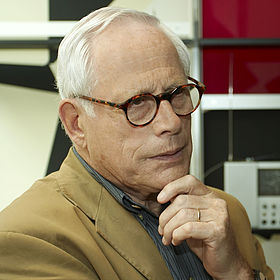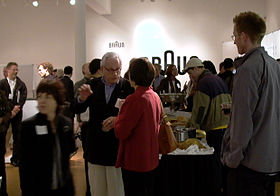- Dieter Rams
-
Dieter Rams (born May 20, 1932 in Wiesbaden, Hesse) is a German industrial designer closely associated with the consumer products company Braun and the Functionalist school of industrial design.
Contents
Life and career
Rams studied architecture at the Werkkunstschule Wiesbaden as well as learning carpentry from 1943 to 1957. After working for the architect Otto Apel between 1953 and 1955 he joined the electronic devices manufacturer Braun where he became chief of design in 1961, a position he kept until 1995.
Rams once explained his design approach in the phrase "Weniger, aber besser" which freely translates as "Less, but better". Rams and his staff designed many memorable products for Braun including the famous SK-4 record player and the high-quality 'D'-series (D45, D46) of 35 mm film slide projectors. He is also known for designing the 606 Universal Shelving System by Vitsœ in 1960.
Many of his designs — coffee makers, calculators, radios, audio/visual equipment, consumer appliances and office products — have found a permanent home at many museums over the world, including MoMA in New York. For nearly 30 years Dieter Rams served as head of design for Braun A.G. until his retirement in 1998. He continues to be highly regarded in design circles and currently has a major retrospective of his work on tour around the world.
In 2010, to mark his contribution to the world of design, he was awarded the 'Kölner Klopfer' prize by the students of the Cologne International School of Design.
Rams' ten principles of "good design"
Good design:[1]
- Is innovative - The possibilities for innovation are not, by any means, exhausted. Technological development is always offering new opportunities for innovative design. But innovative design always develops in tandem with innovative technology, and can never be an end in itself.
- Makes a product useful - A product is bought to be used. It has to satisfy certain criteria, not only functional, but also psychological and aesthetic. Good design emphasizes the usefulness of a product whilst disregarding anything that could possibly detract from it.
- Is aesthetic - The aesthetic quality of a product is integral to its usefulness because products are used every day and have an effect on people and their well-being. Only well-executed objects can be beautiful.
- Makes a product understandable - It clarifies the product’s structure. Better still, it can make the product clearly express its function by making use of the user's intuition. At best, it is self-explanatory.
- Is unobtrusive - Products fulfilling a purpose are like tools. They are neither decorative objects nor works of art. Their design should therefore be both neutral and restrained, to leave room for the user's self-expression.
- Is honest - It does not make a product more innovative, powerful or valuable than it really is. It does not attempt to manipulate the consumer with promises that cannot be kept.
- Is long-lasting - It avoids being fashionable and therefore never appears antiquated. Unlike fashionable design, it lasts many years – even in today's throwaway society.
- Is thorough down to the last detail - Nothing must be arbitrary or left to chance. Care and accuracy in the design process show respect towards the consumer.
- Is environmentally friendly - Design makes an important contribution to the preservation of the environment. It conserves resources and minimizes physical and visual pollution throughout the lifecycle of the product.
- Is as little design as possible - Less, but better – because it concentrates on the essential aspects, and the products are not burdened with non-essentials. Back to purity, back to simplicity.
Less and More exhibition
Less and More is an exhibition of Rams's landmark designs for Braun and Vitsœ. It first travelled to Japan in 2008 and 2009,[2] appearing at the Suntory Museum in Osaka and the Fuchu Art Museum in Tokyo. Between November 2009 and March 2010 it appeared at the Design Museum in London.[3][4] Its last exhibition ended in September 2010 at the Museum für Angewandte Kunst in Frankfurt.[5][6] The exhibit is currently taking place at the San Francisco Museum of Modern Art through February 2012.[7]
Legacy
The appearance of the calculator application included in iOS mimics the appearance of the 1987 Braun ET 66 calculator designed by Rams and Dietrich Lubs. In Gary Hustwit's 2009 documentary film Objectified, Rams states that Apple Inc. is one of the few companies designing products according to his principles.[8][9]
Examples of Rams' works
-
SK 61[10]
References
- ^ SFMOMA Presents Less and More: The Design Ethos of Dieter Rams
- ^ "Less and More: the design ethos of Dieter Rams in Japan". Vitsoe.com. 2008-09-15. http://www.vitsoe.com/en/gb/newsandevents/article/20. Retrieved 2010-06-30.
- ^ "'Less and More' at London's Design Museum". Vitsoe.com. 2009-12-04. http://www.vitsoe.com/en/gb/newsandevents/article/82. Retrieved 2010-06-30.
- ^ "Less and More - The Design Ethos of Dieter Rams". Designmuseum.org. 2009-11-18. http://designmuseum.org/exhibitions/2009/2009-2009-dieter-rams. Retrieved 2010-06-30.
- ^ "Less and More in Frankfurt". Vitsoe.com. 2010-04-19. http://www.vitsoe.com/en/gb/newsandevents/article/92. Retrieved 2010-06-30.
- ^ "Less and More - Das Designethos von Dieter Rams [requires Flash". Angewandtekunst-frankfurt.de. http://www.angewandtekunst-frankfurt.de/deutsch/05_rams.html. Retrieved 2010-06-30..
- ^ "'Less and More': The Design Ethos of Dieter Rams". SFMoMa.com. 2011-08-27. http://www.sfmoma.org/exhib_events/exhibitions/434. Retrieved 2011-09-04.
- ^ "Design evolution". Braun GmbH. 2009. http://www.braun.com/global/world-of-braun/braun-design/design-evolution.html. Retrieved 2011-05-24. "Designer: Dieter Rams and Dietrich Lubs"
- ^ "The Future Of Apple Is In 1960s Braun: 1960s Braun Products Hold the Secrets to Apple's Future". gizmodo.com. Gawker Media. 2008-01-14. http://gizmodo.com/343641/1960s-braun-products-hold-the-secrets-to-apples-future. Retrieved 2010-06-30.
- ^ Dieter Rams and Hans Gugelot, 1956
External links
Categories:- 1932 births
- Living people
- People from Wiesbaden
- German industrial designers
- Commanders Crosses of the Order of Merit of the Federal Republic of Germany
Wikimedia Foundation. 2010.







